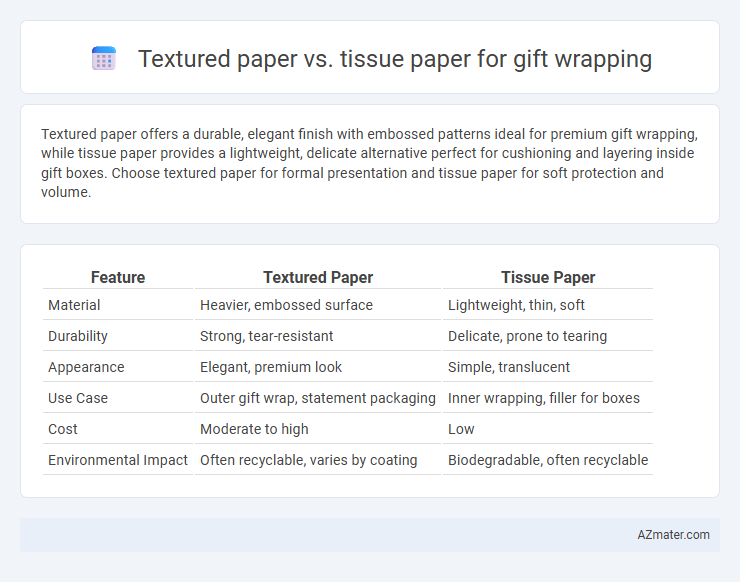Textured paper offers a durable, elegant finish with embossed patterns ideal for premium gift wrapping, while tissue paper provides a lightweight, delicate alternative perfect for cushioning and layering inside gift boxes. Choose textured paper for formal presentation and tissue paper for soft protection and volume.
Table of Comparison
| Feature | Textured Paper | Tissue Paper |
|---|---|---|
| Material | Heavier, embossed surface | Lightweight, thin, soft |
| Durability | Strong, tear-resistant | Delicate, prone to tearing |
| Appearance | Elegant, premium look | Simple, translucent |
| Use Case | Outer gift wrap, statement packaging | Inner wrapping, filler for boxes |
| Cost | Moderate to high | Low |
| Environmental Impact | Often recyclable, varies by coating | Biodegradable, often recyclable |
Introduction to Gift Wrapping Paper Types
Textured paper offers a durable, tactile surface ideal for luxury gift presentation, providing a premium feel that enhances the visual appeal of wrapped items. Tissue paper is lightweight and delicate, commonly used as a protective layer or for adding soft color accents within gift boxes. Selecting between textured and tissue paper depends on the desired aesthetic and the level of protection needed for the gift.
What is Textured Paper?
Textured paper is a type of wrapping material characterized by its raised or embossed surface patterns, offering a tactile and visually appealing finish. Unlike tissue paper, which is lightweight, smooth, and delicate, textured paper provides added durability and an elegant, sophisticated look for gift wrapping. Its varied textures, such as linen, laid, or embossed designs, enhance the overall presentation and make gifts stand out with a premium feel.
What is Tissue Paper?
Tissue paper is a lightweight, thin paper commonly used for gift wrapping, known for its flexibility and softness that easily conforms to various shapes. It provides a delicate and elegant presentation, often used to wrap fragile items or as filler inside gift bags to add volume and color contrast. Unlike textured paper, tissue paper is semi-transparent and less rigid, making it ideal for decorative layering and enhancing the visual appeal of wrapped gifts.
Key Differences Between Textured and Tissue Paper
Textured paper for gift wrapping offers a thicker, more durable surface with embossed or raised patterns that enhance visual appeal and tactile experience, while tissue paper is thin, lightweight, and semi-transparent, primarily used for delicate cushioning and decorative layering. Textured paper holds its shape better for structured wrapping and gift embellishments, whereas tissue paper excels in softness and flexibility, ideal for wrapping fragile items or filling gift bags. Cost and environmental impact differ as textured paper is often more expensive and less recyclable compared to sustainably sourced tissue paper, making material choice dependent on presentation style and practical requirements.
Aesthetic Appeal: Textured Paper vs Tissue Paper
Textured paper offers a sophisticated and tactile surface that enhances the visual depth and luxury of gift wrapping, often featuring embossed patterns or natural fibers for added elegance. Tissue paper provides a lightweight, translucent quality that creates soft layers and subtle color blending, ideal for delicate or minimalist presentations. Choosing textured paper elevates a gift's perceived value through its rich texture, while tissue paper emphasizes gentle aesthetics and ease of manipulation.
Durability and Strength Comparison
Textured paper offers superior durability and strength compared to tissue paper, making it ideal for gift wrapping items that require extra protection and a polished appearance. Its thicker fibers and embossed surface resist tearing and creasing, providing a sturdy wrap that maintains shape during handling and transport. Tissue paper, while lightweight and soft, lacks the structural integrity needed for heavier or irregularly shaped gifts, making it better suited for decorative layering or cushioning rather than standalone wrapping.
Eco-Friendliness and Recyclability
Textured paper is often made from recycled fibers and can be fully recyclable, making it a more eco-friendly option for gift wrapping compared to tissue paper, which is usually thinner, less durable, and often contains dyes or coatings that hinder recycling. Tissue paper typically breaks down quickly but is less likely to withstand multiple uses, reducing its sustainability potential. Choosing textured paper supports more efficient recycling processes and promotes reuse, contributing to reduced waste and environmental impact.
Best Occasions for Each Paper Type
Textured paper is ideal for formal gift wrapping occasions such as weddings, corporate events, and holiday presents due to its elegant and sophisticated appearance. Tissue paper works best for casual celebrations like birthdays, baby showers, and party favors, offering a lightweight and colorful option that adds a playful touch. Choosing textured paper enhances the unwrapping experience with its premium feel, while tissue paper excels in layering and cushioning delicate items.
Cost and Availability Factors
Textured paper for gift wrapping typically costs more due to its thicker material and intricate surface finishes, making it a premium choice often available in specialty stores. Tissue paper tends to be more affordable and widely accessible in most retail outlets, offering a lightweight option ideal for layering or cushioning. Consumers seeking budget-friendly and easily reachable wrapping solutions generally prefer tissue paper, while those valuing luxury and tactile appeal lean towards textured paper despite higher expenses.
Final Verdict: Choosing the Right Paper for Gift Wrapping
Textured paper offers durability and a sophisticated appearance, making it ideal for high-end or formal gift presentations, while tissue paper provides a lightweight, flexible option perfect for cushioning and adding layers of color or softness. Selecting the right paper depends on the occasion and the gift's fragility; textured paper excels in elegance and sturdiness, whereas tissue paper shines in versatility and ease of use. For lasting impact and refined presentation, textured paper is best suited, but tissue paper remains a practical choice for casual, everyday gift wrapping.

Infographic: Textured paper vs Tissue paper for Gift wrapping
 azmater.com
azmater.com